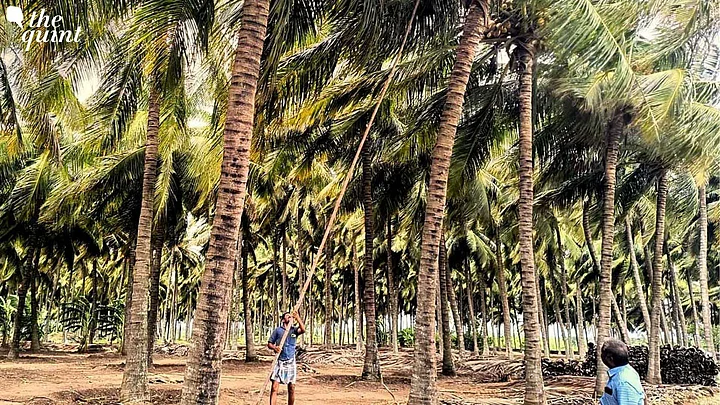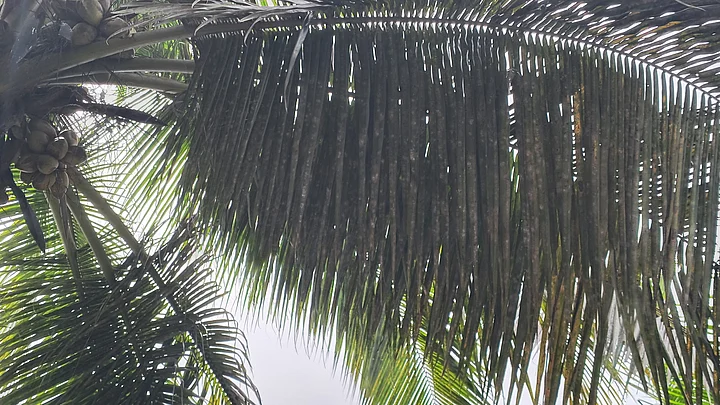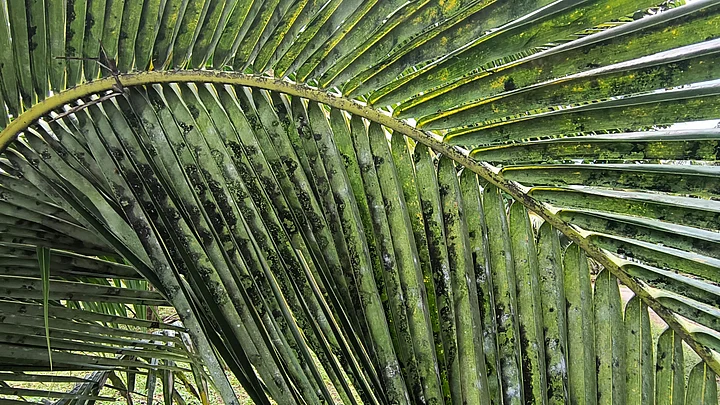Are we prepared for the climate crisis staring us in the face? The Quint wants to go big on telling the most important stories of our time. Support us to tell them. Become a member now.
"We used to get around 100 coconuts from a single tree in a year. Now we just get around 20 or 30," says Kanagaraj, a 43-year-old coconut farmer in Tamil Nadu's Sultanpet.
"Many fall off when they are small and don't grow beyond this," he says, pointing to small, premature coconuts the size of acorns strewn on the ground below the trees.
Just a 90-minute drive from Coimbatore city, Sultanpet and the nearby town of Pollachi form a major coconut-growing region in Tamil Nadu, accounting for nearly 90,000 hectares of coconut plantations. A fact that’s hard to miss in a landscape that is almost entirely made up of endless rows of coconut palms that stretch to the horizon.
But farmers here are now struggling with a decline in coconut yield due to an infestation of whiteflies — something that was unheard of until just a few years ago.
"It takes over five years for a coconut tree to grow and start producing fruit (tender coconut). Even the dwarf variety takes about two years. So, it's not like we can just cut down these infected trees and plant new ones."Kanagaraj
'All the Lush Green Leaves Have Turned Black'
Whiteflies are tiny bugs that resemble small white moths. They feed on the undersides of leaves, draining the plant's nutrients and weakening it over time.
In coconut trees, whitefly infestations are marked by some telltale signs: yellowing leaf tips, white blotches on the undersides, and in severe cases, black sooty mould coating the tops of the leaves. This can be seen on most coconut trees in the area.
When large surfaces of the leaves turn black, it reduces the palm's ability to do photosynthesis and reduces its nutritional intake, in turn reducing its ability to grow fruits.
Panjalingam, a 37-year-old farmer in Poorandampalayam, a village in Sultanpet, inherited his coconut grove from his father. He has spent the past 15 years working full-time to grow his family business.
"I have 10 acres of coconut trees. We sell the tender coconuts as they are, but we also separate the mature coconuts into husk, copra, and oodu (the woody hard shell or endocarp) and sell them to different small industries nearby," he tells The Quint.
But with the worsening of whitefly infestation over the past few years, and a particularly bad outbreak this year, he is among those affected.
"They stick to the bottom of the leaves decaying the leaves. Because of this, the yield this year has been half of what we got last year by this time. Because of this, the cost has gone up too from around Rs 15 per kg in 2023 to Rs 30 now."Panjalingam, 37
Panjalingam's father, 68-year-old Subramaniyam, chimes in, saying he's seen these trees grow before his eyes and watched them change for the worse.
"They used to be so lush green like this," he says, pointing with his cane at a tender green hibiscus leaf on a shrub. "Now they have all turned black, and are dying."
"Until about five years ago, one tree would give around 150 -200 coconuts." he said, adding that in his youth, he never had to deal with whiteflies on coconut trees. "These are new challenges that we have never faced."
A Widespread Issue...
The problem isn’t confined to this region alone.
In April, Agriculture and Farmers’ Welfare Minister MRK Panneerselvam had said that 1.9 lakh of the 12 lakh acres of coconut cultivation in all of Tamil Nadu has been affected by the worsening whitefly infestation.
Speaking to The Quint, Jayanath R, Deputy Director (Dev), Coconut Development Board, says that even the neighbouring states of Karnataka and Kerala are grappling with the same issue.
In Karnataka, whiteflies have affected 1.48 lakh hectares of coconut plantations across 14 districts, Minister for Industries M B Patil informed the Legislative Assembly in March.
"The 2024-2025 data has not been published yet so it's difficult to give exact data on how much the yield has reduced. The exact extent of impact of whitefly on coconut yield is also not very clear. But our observation is the same as what you saw. We are also seeing that so many diseases are now affecting coconuts, which has reduced the output."Jayanath R
He further explains, "We started noticing whitefly infestation from 2019 onwards. Initially it wasn’t widely seen in coconut, but now It has been recorded in all the major coconut producing regions in Tamil Nadu, Kerala and Karnataka, and even parts of Odisha. The infestation has majorly increased since 2024."
Jayanath also adds that since 2019, more species of whitefly have emerged. "Three to four species have been isolated since then. The problem is that it is very difficult to contain. If palm trees in one area is affected, we have observed that it spreads very fast."
Low Yield Equals High Prices
According to the Coconut Development Board website, the price of coconut in Pollachi is Rs 66 per kg as of 24 June.
On the other hand, copra now costs Rs 235 per kg. "Just two years ago, it cost around Rs 70," Eesan Murugasamy, founder of the Tamil Nadu Farmers Protection Association, tells The Quint.
For farmers like Kanagaraj and Panjalingam, there’s little choice but to raise the price of their coconuts. For now, buyers are still interested, but they worry that if prices keep climbing, demand may dry up, and profits along with it.
"We’re already buying coconuts from others to sell as copra to keep our business running," Panjalingam explains.
"We buy coconuts at Rs 30, dry them, separate the copra, and sell it for Rs 120. But we have to pay for labour too. The profit margin is shrinking. I don’t know how long this will be sustainable."Panjalingam
Speaking to The Quint, Kannan, a tender coconut vendor on Coimbatore-Palakkad highway who sells them for Rs 60 per fruit, said, "Due to the coconut shortage in Pollachi, I can’t afford to stock up. The quality of what we get is also not great. They don't have much water and dry out fast."
Apart from the cost of coconuts itself going up, "this will certainly have a trickledown effect on other industries too," says Jayanath.
"Kerala is already facing a major copra shortage, which is where coconut oil is extracted from. This will not only lead to a further spike in the cost of coconut oil, but also encourage more adulteration."Jayanath R, Deputy Director (Dev), Coconut Development Board
In April, AIADMK MLA from Pollachi, V Jayaraman, raised the issue at the Tamil Nadu Assembly session, saying, "Coir, one of the byproducts of coconut, is exported to China, and the revenue earned from China alone is Rs 4,000 crore. But because of the infestation, exports have been hit as 25 percent of the trees were cut."
Climate Change at the Core of Crisis
According to experts, the spike in pests like whiteflies is a result of erratic climatic variations and climate change.
Several studies have shown that warmer temperatures, erratic rainfall, and rising atmospheric CO₂ create ideal conditions for agricultural pests to thrive, including whiteflies.
"Other pests like black headed caterpillar is also affecting coconut trees. Extreme heat coupled with increased humidity create the perfect climate for these pests to propagate," explains Jayanath.
However, he adds, "The lower yield isn't just because of pests like whitefly, it’s a mix of reasons. Drought is one other major reason, and erratic rains with stretches of extreme heat is yet another."
According to the Indian Council of Agricultural Research, coconuts grow best at a range of 22°C to 32°C, with over 60 percent humidity.
"Last year, we had unexpected heat. The temperature went up to around 40 to 45 degrees, which isn’t common here," SD Mandharasalam, a local leader in Sulur, Sultanpet and member of the Tamil Nadu Farmers Protection Association, tells The Quint.
"When it gets this hot, groundwater levels drop. Coconut trees need a lot of water, about 80 litres a day, and need to be watered three to four times daily. Many farmers rely entirely on borewells, so when groundwater decreases, it’s hard to meet the trees' needs. That water stress causes the fruits to fall early and the coconuts will have less water in them,"SD Mandharasalam
Another important point to note is that the effects of stressors on yield often show up with a delay.
"The impact of last year's drought, extreme heat, and erratic rainfall in 2023-2024 is only becoming visible now. So the decline in yield we're seeing now is likely the result of these factors building up over the past couple of years," explains Jayanath.
Zooming out, this is a crisis that is impacting agricultural yields across the board. A new report in the journal Nature estimates that for every 1°C rise in temperature, global food production capacity drops by 120 calories per person per day, affecting staples like corn, soybeans, rice, wheat, cassava, and sorghum.
How Are Farmers Coping?
According to Jayanath, the only way to effectively manage whiteflies is by spraying neem seed extract oil on the underside of the palm leaves. But that solution comes with its own set of challenges.
"Even if we spray, they come back in about 10 days," says Kanagaraj, who tried the method but eventually gave up, saying the cost of repeated applications was simply too high.
Jayanath further says adding potassium fertilisers can also help palms resist pests to an extent, but many farmers hesitate to use them. At Rs 35 per kg, he says, the expense is often more than they can afford.
"The problem worsens when the palms grow too tall," Jayanath explains. "Some farmers can’t manage the additional cost of hiring special equipment to spray at those heights."
While the Coconut Development Board has launched programmes to help farmers tackle these emerging pest threats, Jayanath admits progress is slow.
"There's a sustainability and productivity improvement programme underway that's demonstrating sustainable practices to coconut farmers. These efforts have to happen at the community level as it won't help if only a few individuals adopt them. The programme also promotes better cropping systems, like intercropping with cash crops such as cocoa and banana, so farmers can offset losses from low coconut yields. We will be covering all the major coconut producing regions through this programme in the next two years."Jayanath R
"But any corrective measure, any pesticide or fertiliser you add to a palm will take a couple of years to show results," he says.
Research to develop more targeted, effective insecticides is underway — but, as he puts it, "that will take more time."


